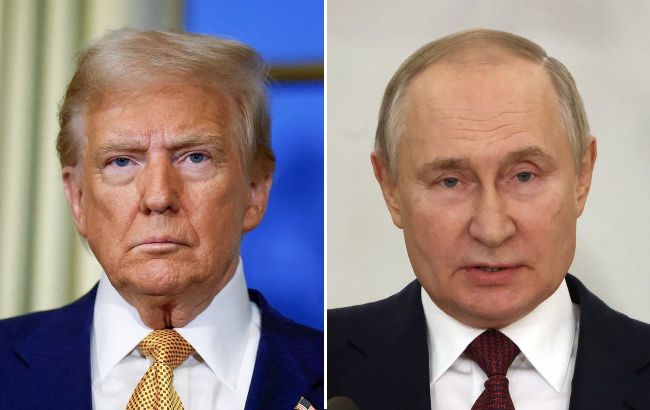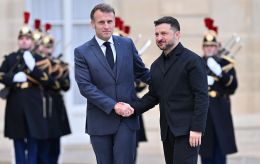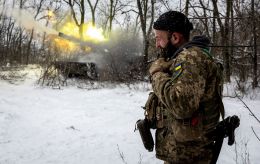Trump draws a line on Ukraine: What it means for Putin and the war
 Today is the deadline for Trump's ultimatum to Putin to end Russia's war against Ukraine (collage: RBC-Ukraine)
Today is the deadline for Trump's ultimatum to Putin to end Russia's war against Ukraine (collage: RBC-Ukraine)
Donald Trump threatened Russia with tariffs and sanctions if the Kremlin did not stop the war by August 8. Despite talks with Putin and new US tariffs, Russian troops continue advancing on the front lines and attacking Ukraine with drones.
What to expect after Trump's deadline? Read below.
Key questions:
- When and how Trump's position on the war shifted
- What strategy Trump chose regarding Russia
- Why the Witkoff-Putin meeting was in doubt and what followed in Moscow
- Scenarios for what happens next
Today is the deadline Trump set for Putin. The US President threatened Russia with harsh sanctions and tariffs if Moscow does not stop its war against Ukraine by August 8. The exact list of restrictions that the White House might impose has not been publicly disclosed. However, certain statements and specific steps taken by Trump suggest the focus is primarily on secondary sanctions against Russia's partner countries - buyers of its oil.
This is not Trump's first deadline for Moscow - the one he voiced in mid-July was expected to expire around September 2–3. But just two weeks later, he shortened the timeline to August 8. Not waiting for the date, the American President raised tariffs on India, citing its large-scale oil purchases from the aggressor country. Trump also sent his Special Envoy, Steve Witkoff, for negotiations with Putin.
And although Trump's step-by-step strategy to "rein in" Moscow has not yet yielded tangible results, the trajectory he has chosen gives cautious reason to believe that this time, the White House is serious. At least – more serious than two months or half a year ago.
"We still have a ways to go here, but we certainly are closer today then we were yesterday, where we weren't close at all," said Secretary of State Marco Rubio after the Witkoff-Putin meeting on August 6.
"Russia now seems to be more inclined toward a ceasefire – the pressure is working," Ukrainian President Volodymyr Zelenskyy later said the same day.
Economic encirclement
In recent weeks, RBC-Ukraine has repeatedly heard from politicians, officials, and diplomats that the chances of a ceasefire this year have grown. From the outside, such expectations might seem baseless, as Russia continues to apply heavy pressure on the front lines, recruit soldiers, ramp up military-industrial production, and regularly shell Ukrainian cities.
Several rounds of talks in Istanbul yielded results on the humanitarian track - numerous prisoner exchanges were carried out. But on everything else, the Russians simply refused to engage in substantive agreements. Putin and his officials continued to publicly repeat only their maximalist demands: Ukraine's withdrawal from four regions, not to mention renouncing Crimea, downsizing the military, adopting neutral status, and so on.
However, informed sources told RBC-Ukraine that some optimism about a truce is tied to a shift in Donald Trump's approach to the Russia-Ukraine war. The turning point in the American president’s position can be traced back to early July. The timing coincided with the end of the 12-day war between Iran and Israel, which Trump managed to "cool down" after intervening.
On July 3, the US President held a phone call with Putin, discussing the war in Ukraine. After the call, Trump said he was "not satisfied with his position" on Ukraine and had made "no progress" with him. That very night, Moscow attacked Kyiv with a record number of drones and a dozen missiles. The next day, the US President spoke with Volodymyr Zelenskyy. Ukrainian sources described the conversation as "more positive than ever before."
 Trump and Zelenskyy meeting at the NATO summit on June 25 (photo: Office of the President of Ukraine)
Trump and Zelenskyy meeting at the NATO summit on June 25 (photo: Office of the President of Ukraine)
After that, Trump and his team began escalating their rhetoric toward Putin and Moscow. More statements emerged about transferring or selling weapons and air defense systems to Ukraine. Then Trump moved to implement a kind of "economic encirclement" of Moscow, pressuring its partners.
"I think Trump's initial 50-day deadline, and now the new one ending today - they are interconnected. On one hand, they're meant to signal to Putin that we're gradually increasing the heat under your pot. Whether you like it or not, we will keep turning it up unless you move toward us," said Fedir Venislavskyi, a Member of Parliament and member of the Verkhovna Rada Committee on National Security, Defense, and Intelligence, in a comment to RBC-Ukraine.
India was the first to come under tariff fire, the second-largest importer of Russian oil after China. Public estimates show India buys about 38% of its crude oil from Russia, while China accounts for 47%. Oil revenues remain a pillar of Russia's economy and a major source of its budget.
Trump initially raised tariffs on all Indian goods to 25%, set to take effect on August 7, with an additional 25% kicking in on August 28. According to Bloomberg, India temporarily halted its oil purchases from Russia yesterday in light of the new US tariffs. The White House has also warned that similar measures may be applied to other countries, including China. Although overall, Trump is approaching Beijing more cautiously - Western media note he still hopes for a "small deal" with China, whose importance to him goes far beyond the Russia–Ukraine conflict.
RBC-Ukraine's sources believe Moscow didn't take Trump's sanctions threats seriously until the very end. Trump himself has repeatedly given reasons to underestimate his statements, frequently throwing around timelines of "a hundred days" or "two to three weeks." Thus, Witkoff's primary mission during his Moscow visit was to communicate the seriousness of Trump's intentions to Putin.
First shifts
Informed Ukrainian sources told RBC-Ukraine that as of August 5, Witkoff's trip to the Kremlin was still uncertain, as Putin had not confirmed a personal meeting. The details and content of the conversation that did take place the next day were not disclosed. Trump described it as "very productive," achieving "significant progress," while acknowledging he "wouldn't call it a breakthrough."
Rubio said that for the first time, the Russians had voiced specific conditions under which they were willing to end the war. According to him, territorial issues would be central, and concessions would be needed from both sides. Meanwhile, Putin's Aide Ushakov claimed that an American proposal had been made that Moscow considered acceptable.
It's unclear whether the Russians outlined a realistic vision for the future of the occupied Ukrainian territories to the Americans. Nor is it clear whether what is acceptable for the Kremlin will also be acceptable to Ukraine.
Previously, some RBC-Ukraine sources suggested Russia's non-negotiable goal was to reach the borders of both Donbas regions.
"At that point, they could say: here, the two regions where it all started are now ours. As for parts of Zaporizhzhia and Kherson, we'll consider them 'occupied by Ukraine' - temporarily, of course," one source explained.

Witkoff-Putin meeting at the Kremlin on August 6 (photo: GettyImages)
Meanwhile, another informed RBC-Ukraine source discussing Russia's ultimatums voiced in Istanbul argued: Ukraine's withdrawal from four regions is deliberately exaggerated, a "high starting point" strategy, and there may be room for maneuver on this issue.
The main public outcome of the Kremlin meeting was the planning of a meeting between Trump and Putin – the last time the Russian President met with an American counterpart was before the full-scale invasion, in 2021.
"The fact that a Trump-Putin meeting will happen, in my view, means that Putin is going into it under pressure. Trump seems to be pressing him hard. Putin realizes he can't get out of it without offending Trump," the Russian opposition political scientist Abbas Gallyamov told RBC-Ukraine.
Gallyamov believes Putin is ready to end the war, but only on his own terms, which he can present as a victory. At the same time, the Russian President doesn't want to personally escalate tensions with Trump, Gallyamov said. So, if pressure on Putin doesn't intensify - he'll keep fighting. Conversely, if the Kremlin truly feels the impact of US threats, the cost of continuing the war may become too high, forcing Putin to stop.
"After meeting with Witkoff, they really faced a dilemma and are now looking for a solution. Primarily regarding territory - what they can give up, where they can make concessions. After the meeting, Russia's Security Council met for six hours. Today (August 7 – ed.) - for another five," one source told RBC-Ukraine.
Following his meeting with Putin, Trump also wants to hold a trilateral summit with Zelenskyy. Moreover, according to several Western media outlets, the US President allegedly plans to meet with the Kremlin chief only if he also agrees to meet with the Ukrainian President. So far, Putin has not responded to this idea. RBC-Ukraine sources say Ukraine supports the inclusion of Europe in the negotiation process. However, that proposal is still under discussion.
"Given that Trump is simultaneously sending positive signals about constructive talks while continuing to impose sanctions, raising tariffs against India, it looks like there's no concrete agreement yet. He's not ruling out any scenario. He's just trying to make it easier for Putin to move in the right direction," Gallyamov believes.
What's next
The Kremlin has already announced its agreement to meet with Trump, while the White House has not yet confirmed it. So, there are several possible scenarios – ranging from harsher moves by Trump to a major breakthrough that could lead to a ceasefire and, possibly, the end of the war.
The first scenario is probably undesirable but quite possible: on August 8, the deadline day, Trump imposes no new sanctions on Russia or its partners. Already at that point, the "fork in the road" emerges. On one hand, Putin may see this as loosening the noose around his neck and try again to force the White House to play by his rules - vague promises, minor concessions, and avoiding a meeting with Zelenskyy.
In that case, the Trump-Putin meeting may happen, but yield no results. Russian troops could continue their offensive campaigns at least through September-October, launching assaults not just in Donetsk but intensifying efforts in the Zaporizhzhia direction.
On the other hand, the measures already taken and the show of serious intent from the US may be enough to make Putin more willing to engage in substantive talks. Yesterday, Trump himself said that the decision to impose new anti-Russian sanctions on August 8 "will depend on the leadership of Russia."
 Trump still seems to be expecting some moves from Putin (photo: GettyImages)
Trump still seems to be expecting some moves from Putin (photo: GettyImages)
Another, entirely opposite, outcome would be that on the deadline day, the US President imposes the maximum package of sanctions and tariffs he can enact by executive order, without Congress. Then, depending on how the Kremlin reacts, this could either force Putin to quickly wind down military operations or, conversely, push him into a corner where he lashes out even harder.
"Trump is obviously interested in speeding up the cessation of hostilities, even in the form of a ceasefire. And for that, he needs to increase pressure on Putin. But at the same time, I think he's not interested in completely breaking Putin. So he'll keep raising the pressure gradually, surrounding Putin with tension on all sides, but not pushing too hard, so that he doesn't feel like a rat backed into a corner. And Putin must know that if the economy collapses – eventually, his whole system will collapse," Gallyamov states.
The third, middle, scenario assumes that on August 8, Trump introduces another portion of restrictions as a further signal to Moscow that he's willing to go further, but how far depends on Moscow itself. After that, Putin agrees to meet with Zelenskyy - the meeting could take place shortly before or after the one with Trump.
"I think Trump will apply an intermediate level of sanctions today - it's unlikely he'll implement the full package. They may be painful, but not total. If I were to predict, I'd say the Trump-Putin meeting will happen within 7-10 days, roughly by August 15–20. After that, in my personal forecast, a three-way presidential meeting could happen between August 15-25," Venislavskyi suggests.
The key turning point in this scenario is what results the trilateral summit yields. One possibility: Putin might try to sell Trump on a so-called "air truce" - halting attacks on Ukrainian towns beyond the front line. But such a gesture would likely not be seen as a breakthrough by the US.
"Trump keeps saying that people need to stop dying. He's repeatedly stated how many Ukrainian and Russian soldiers are dying. One of the main messages in his rhetoric is that people need to stop killing people. So, just an air truce won't be enough for Trump. From what I understand of his logic, he expects the meeting to produce a declaration to end hostilities. Then the process would move toward a settlement and drafting of some kind of agreement to end the war on an international level," Venislavskyi predicts.
All these scenarios share one thing – many fragile and shifting variables. What will Trump do? Will he go all the way, ignoring Moscow's false promises? How will Putin respond? Will he agree to meet with Zelenskyy? Does the Kremlin chief fully grasp the real prospects of his economy, or are they clouded by imperial dreams? What compromises is the Kremlin prepared for? How will Ukraine and its people respond? How will India and China react?
That list of variables could go on and on. Despite high uncertainty, Trump's current strategy is clearly shifting the conflict's dynamic. For the first time in a long time, Moscow faces strong external motivation to find a way out of the war. If we truly are on the path toward ending it - we shouldn't expect the finish line to be very close.

